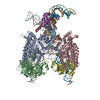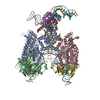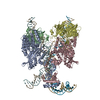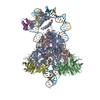+ Open data
Open data
- Basic information
Basic information
| Entry | Database: PDB / ID: 6oem | ||||||||||||||||||||||||||||||||||||||||||
|---|---|---|---|---|---|---|---|---|---|---|---|---|---|---|---|---|---|---|---|---|---|---|---|---|---|---|---|---|---|---|---|---|---|---|---|---|---|---|---|---|---|---|---|
| Title | Cryo-EM structure of mouse RAG1/2 PRC complex (DNA0) | ||||||||||||||||||||||||||||||||||||||||||
 Components Components |
| ||||||||||||||||||||||||||||||||||||||||||
 Keywords Keywords | RECOMBINATION/DNA / V(D)J recombination / DNA Transposition / RAG / SCID / RECOMBINATION / RECOMBINATION-DNA complex | ||||||||||||||||||||||||||||||||||||||||||
| Function / homology |  Function and homology information Function and homology information: / regulation of tolerance induction / calcium-dependent protein kinase regulator activity / positive regulation of myeloid progenitor cell differentiation / regulation of T cell mediated immune response to tumor cell / positive regulation of mismatch repair / negative regulation of apoptotic cell clearance / plasmacytoid dendritic cell activation / negative regulation of RNA polymerase II transcription preinitiation complex assembly / T-helper 1 cell activation ...: / regulation of tolerance induction / calcium-dependent protein kinase regulator activity / positive regulation of myeloid progenitor cell differentiation / regulation of T cell mediated immune response to tumor cell / positive regulation of mismatch repair / negative regulation of apoptotic cell clearance / plasmacytoid dendritic cell activation / negative regulation of RNA polymerase II transcription preinitiation complex assembly / T-helper 1 cell activation / T-helper 1 cell differentiation / mature B cell differentiation involved in immune response / positive regulation of myeloid cell differentiation / myeloid dendritic cell activation / positive regulation of toll-like receptor 2 signaling pathway / positive regulation of dendritic cell differentiation / C-X-C chemokine binding / negative regulation of CD4-positive, alpha-beta T cell differentiation / positive regulation of toll-like receptor 9 signaling pathway / B cell homeostatic proliferation / neutrophil clearance / negative regulation of T cell differentiation in thymus / positive regulation of glycogen catabolic process / DN2 thymocyte differentiation / DNA geometric change / pre-B cell allelic exclusion / positive regulation of toll-like receptor 4 signaling pathway / endothelial cell chemotaxis / RAGE receptor binding / positive regulation of organ growth / eye development / positive regulation of interleukin-1 production / Regulation of TLR by endogenous ligand / bubble DNA binding / regulation of behavioral fear response / V(D)J recombination / myeloid cell differentiation / negative regulation of T cell apoptotic process / alphav-beta3 integrin-HMGB1 complex / myeloid progenitor cell differentiation / Apoptosis induced DNA fragmentation / inflammatory response to antigenic stimulus / phosphatidylinositol-3,4-bisphosphate binding / macrophage activation involved in immune response / negative regulation of thymocyte apoptotic process / histone H3K4me3 reader activity / positive regulation of monocyte chemotaxis / MyD88 deficiency (TLR2/4) / positive regulation of monocyte chemotactic protein-1 production / regulation of nucleotide-excision repair / endothelial cell proliferation / phosphatidylinositol-3,5-bisphosphate binding / positive regulation of chemokine (C-X-C motif) ligand 2 production / cellular response to interleukin-7 / glycogen catabolic process / apoptotic cell clearance / positive regulation of vascular endothelial cell proliferation / IRAK4 deficiency (TLR2/4) / regulation of T cell differentiation / dendritic cell chemotaxis / MyD88:MAL(TIRAP) cascade initiated on plasma membrane / supercoiled DNA binding / positive regulation of DNA binding / DNA binding, bending / organ growth / positive regulation of T cell differentiation / T cell lineage commitment / positive regulation of wound healing / phosphatidylserine binding / B cell lineage commitment / positive regulation of sprouting angiogenesis / chemoattractant activity / endoplasmic reticulum-Golgi intermediate compartment / phosphatidylinositol-3,4,5-trisphosphate binding / TRAF6 mediated NF-kB activation / T cell homeostasis / negative regulation of type II interferon production / DNA topological change / Advanced glycosylation endproduct receptor signaling / positive regulation of activated T cell proliferation / negative regulation of blood vessel endothelial cell migration / positive regulation of interferon-alpha production / positive regulation of interleukin-10 production / T cell differentiation / positive regulation of blood vessel endothelial cell migration / Pyroptosis / protein kinase activator activity / protein autoubiquitination / four-way junction DNA binding / condensed chromosome / DNA polymerase binding / phosphatidylinositol-4,5-bisphosphate binding / transcription repressor complex / positive regulation of interleukin-12 production / positive regulation of autophagy / phosphatidylinositol binding / activation of innate immune response / lung development / positive regulation of interferon-beta production / response to glucocorticoid Similarity search - Function | ||||||||||||||||||||||||||||||||||||||||||
| Biological species |   Homo sapiens (human) Homo sapiens (human) | ||||||||||||||||||||||||||||||||||||||||||
| Method | ELECTRON MICROSCOPY / single particle reconstruction / cryo EM / Resolution: 3.6 Å | ||||||||||||||||||||||||||||||||||||||||||
 Authors Authors | Chen, X. / Cui, Y. / Zhou, Z.H. / Yang, W. / Gellert, M. | ||||||||||||||||||||||||||||||||||||||||||
| Funding support |  United States, 1items United States, 1items
| ||||||||||||||||||||||||||||||||||||||||||
 Citation Citation |  Journal: Nat Struct Mol Biol / Year: 2020 Journal: Nat Struct Mol Biol / Year: 2020Title: Cutting antiparallel DNA strands in a single active site. Authors: Xuemin Chen / Yanxiang Cui / Robert B Best / Huaibin Wang / Z Hong Zhou / Wei Yang / Martin Gellert /  Abstract: A single enzyme active site that catalyzes multiple reactions is a well-established biochemical theme, but how one nuclease site cleaves both DNA strands of a double helix has not been well ...A single enzyme active site that catalyzes multiple reactions is a well-established biochemical theme, but how one nuclease site cleaves both DNA strands of a double helix has not been well understood. In analyzing site-specific DNA cleavage by the mammalian RAG1-RAG2 recombinase, which initiates V(D)J recombination, we find that the active site is reconfigured for the two consecutive reactions and the DNA double helix adopts drastically different structures. For initial nicking of the DNA, a locally unwound and unpaired DNA duplex forms a zipper via alternating interstrand base stacking, rather than melting as generally thought. The second strand cleavage and formation of a hairpin-DNA product requires a global scissor-like movement of protein and DNA, delivering the scissile phosphate into the rearranged active site. | ||||||||||||||||||||||||||||||||||||||||||
| History |
|
- Structure visualization
Structure visualization
| Movie |
 Movie viewer Movie viewer |
|---|---|
| Structure viewer | Molecule:  Molmil Molmil Jmol/JSmol Jmol/JSmol |
- Downloads & links
Downloads & links
- Download
Download
| PDBx/mmCIF format |  6oem.cif.gz 6oem.cif.gz | 479.2 KB | Display |  PDBx/mmCIF format PDBx/mmCIF format |
|---|---|---|---|---|
| PDB format |  pdb6oem.ent.gz pdb6oem.ent.gz | 360.6 KB | Display |  PDB format PDB format |
| PDBx/mmJSON format |  6oem.json.gz 6oem.json.gz | Tree view |  PDBx/mmJSON format PDBx/mmJSON format | |
| Others |  Other downloads Other downloads |
-Validation report
| Arichive directory |  https://data.pdbj.org/pub/pdb/validation_reports/oe/6oem https://data.pdbj.org/pub/pdb/validation_reports/oe/6oem ftp://data.pdbj.org/pub/pdb/validation_reports/oe/6oem ftp://data.pdbj.org/pub/pdb/validation_reports/oe/6oem | HTTPS FTP |
|---|
-Related structure data
| Related structure data |  20030MC  6oenC  6oeoC  6oepC  6oeqC  6oerC  6v0vC M: map data used to model this data C: citing same article ( |
|---|---|
| Similar structure data |
- Links
Links
- Assembly
Assembly
| Deposited unit | 
|
|---|---|
| 1 |
|
- Components
Components
-V(D)J recombination-activating protein ... , 2 types, 4 molecules ACBD
| #1: Protein | Mass: 119388.352 Da / Num. of mol.: 2 / Mutation: E962Q Source method: isolated from a genetically manipulated source Source: (gene. exp.)   Homo sapiens (human) Homo sapiens (human)References: UniProt: P15919, Hydrolases; Acting on ester bonds, RING-type E3 ubiquitin transferase #2: Protein | Mass: 59138.410 Da / Num. of mol.: 2 Source method: isolated from a genetically manipulated source Source: (gene. exp.)   Homo sapiens (human) / References: UniProt: P21784 Homo sapiens (human) / References: UniProt: P21784 |
|---|
-DNA chain , 4 types, 4 molecules GIFJ
| #3: DNA chain | Mass: 18809.023 Da / Num. of mol.: 1 / Source method: obtained synthetically / Source: (synth.)  |
|---|---|
| #4: DNA chain | Mass: 15275.817 Da / Num. of mol.: 1 / Source method: obtained synthetically / Source: (synth.)  |
| #5: DNA chain | Mass: 15528.942 Da / Num. of mol.: 1 / Source method: obtained synthetically / Source: (synth.)  |
| #6: DNA chain | Mass: 18792.076 Da / Num. of mol.: 1 / Source method: obtained synthetically / Source: (synth.)  |
-Protein , 1 types, 2 molecules NH
| #7: Protein | Mass: 16444.963 Da / Num. of mol.: 2 Source method: isolated from a genetically manipulated source Source: (gene. exp.)  Homo sapiens (human) / Gene: HMGB1, HMG1 / Production host: Homo sapiens (human) / Gene: HMGB1, HMG1 / Production host:  |
|---|
-Non-polymers , 2 types, 4 molecules 


| #8: Chemical | | #9: Chemical | |
|---|
-Details
| Has protein modification | Y |
|---|
-Experimental details
-Experiment
| Experiment | Method: ELECTRON MICROSCOPY |
|---|---|
| EM experiment | Aggregation state: PARTICLE / 3D reconstruction method: single particle reconstruction |
- Sample preparation
Sample preparation
| Component | Name: RAG1/2 pre-reaction complex / Type: COMPLEX / Entity ID: #1-#7 / Source: MULTIPLE SOURCES |
|---|---|
| Molecular weight | Units: MEGADALTONS / Experimental value: YES |
| Source (natural) | Organism:  |
| Buffer solution | pH: 7.4 |
| Specimen | Embedding applied: NO / Shadowing applied: NO / Staining applied: NO / Vitrification applied: YES |
| Specimen support | Details: unspecified |
| Vitrification | Cryogen name: ETHANE |
- Electron microscopy imaging
Electron microscopy imaging
| Experimental equipment |  Model: Titan Krios / Image courtesy: FEI Company |
|---|---|
| Microscopy | Model: FEI TITAN KRIOS |
| Electron gun | Electron source:  FIELD EMISSION GUN / Accelerating voltage: 300 kV / Illumination mode: FLOOD BEAM FIELD EMISSION GUN / Accelerating voltage: 300 kV / Illumination mode: FLOOD BEAM |
| Electron lens | Mode: BRIGHT FIELD |
| Image recording | Electron dose: 57 e/Å2 / Film or detector model: GATAN K2 SUMMIT (4k x 4k) |
- Processing
Processing
| Software | Name: PHENIX / Version: 1.14_3260: / Classification: refinement | ||||||||||||||||||||||||
|---|---|---|---|---|---|---|---|---|---|---|---|---|---|---|---|---|---|---|---|---|---|---|---|---|---|
| EM software | Name: PHENIX / Category: model refinement | ||||||||||||||||||||||||
| CTF correction | Type: PHASE FLIPPING AND AMPLITUDE CORRECTION | ||||||||||||||||||||||||
| 3D reconstruction | Resolution: 3.6 Å / Resolution method: FSC 0.143 CUT-OFF / Num. of particles: 109865 / Symmetry type: POINT | ||||||||||||||||||||||||
| Refine LS restraints |
|
 Movie
Movie Controller
Controller





















 PDBj
PDBj

























































